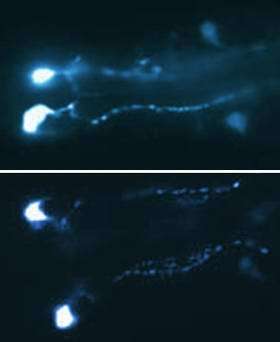Scientists teach worms to learn

Worms, like people, tend to avoid foods that have made them sick in the past. By coaxing worms to select only healthy choices from a menu of bacteria, Rockefeller scientists show that one brain chemical, serotonin, helps cement behavior.
Image: Specific neurons express serotonin (bright areas of image) in response to learning. In worms that were trained to avoid poisonous bacteria (top), more serotonin was expressed than in worms that were not trained (bottom).
Thanks to their simple 302-cell nervous system, the worm is a great model for biologists studying how brain cells work. Unfortunately, worms are not known for their memory. So when Rockefeller University’s Cori Bargmann wanted to study how worms can form memories based on odors, she first needed a way to prove worms could learn and remember.
Yun Zhang, a postdoctoral researcher in Bargmann’s lab, asked herself what kinds of learning a worm really has to do. And she focused on one, near universal behavior that is present in animals ranging from fish to mice to humans: the memory that is formed after eating something that makes you sick. This memory is so strong, in fact, that people will experience nausea years after their initial encounter with an adverse food reaction. Bargmann calls it the “most robust form of learning in animals.”
Their findings, released today in the November 10 issue of the journal Nature, show not only that the worm learns to avoid food that makes it sick, but also that this memory is accompanied by a surge of the neurotransmitter serotonin, which may cement the negative reinforcing behavior. The research, which points to a conserved, ancestral role for serotonin in communication between internal organs and the nervous system, may have implications for the treatment of nausea induced by chemotherapy drugs.
“In the past, it’s been difficult for us to get the worm to learn anything, so we couldn’t take advantage of their simple nervous system and ask the kinds of questions we wanted to ask,” says Bargmann, Torsten N. Wiesel Professor and head of the Laboratory of Neural Circuits and Behavior at Rockefeller and an investigator at the Howard Hughes Medical Institute.
A roundworm’s diet consists of a variety of bacteria that live in the soil. Some bacteria are beneficial, some cause disease and still others are poisonous. “We don’t know if animals experience nausea, but we do know that animals will reject food after a single bad experience,” says Bargmann. “We were using this very powerful, very fundamental form of learning about food as a way to try and teach worms.”
To find out if worms could learn to avoid bacteria that would make them sick, Zhang, Bargmann and co-author Hang Lu developed a series of experiments. First, the researchers gave the worms two bacteria to choose from, one pathogenic and one harmless. After a training period, the worms consistently rejected the pathogenic bacteria.
Then, to be sure that the worms had formed a memory based on their experience with the pathogenic bacteria, and were not simply making lucky guesses, Lu, an MIT-trained engineer, designed an eight-armed “worm maze” using the same techniques that engineers use to construct microelectronic devices.
The maze served as a type of multiple-choice, rather than true-false, test, offering the worms four different bacteria (each bacterium was placed in two of the maze’s eight chambers). After about four hours, the worms started to reject the bad bacteria. Interestingly, Bargmann notes, after a longer time, the worms learned to like good bacteria, although more research needs to be done to understand why.
At the molecular level, the researchers found that the neurons of worms that ingested pathogenic bacteria produced an abundance of the neurotransmitter serotonin. And serotonin production is one of the critical components of learning.
In all animals, including humans, the neurotransmitter serotonin communicates information from the internal organs to the nervous system. The nausea associated with chemotherapy, for example, is based on serotonin release, and the anti-nausea drugs that doctors give to chemotherapy patients are serotonin blockers.
“Doctors tell people who are undergoing chemotherapy not to eat any strongly flavored foods or any foods that they really love because the patients won’t be able to eat them after treatment,” Bargmann says. “That’s a pretty clear indication that there is a form of human learning that may be using a similar mechanism.”
Zhang found that the serotonin-producing neurons communicate with a set of neurons downstream from the simpler odor response. The researchers hypothesize that this is how the worm can connect the experience “I am sick” with the information “here’s what I’m smelling.”
Unexpectedly, Zhang also found that not only do the neurons release more serotonin, they produce much more of it. The researchers found that this increase in serotonin production, which had not been previously observed, resulted from changes in the enzyme that makes serotonin and an increase in the transcription of this enzyme.
“Over the course of about 24 hours, serotonin seems to go from just released to more synthesis and more release to more enzyme and more synthesis and more release,” says Bargmann.
This finding, Bargmann says, could represent an unexpected avenue for developing new treatments for chemotherapy-induced nausea.
“The current method to treat nausea is to block serotonin receptors,” says Bargmann. “And although it’s still a preliminary finding, maybe serotonin production could be targeted at a much earlier stage. But we don't know yet if this process exists in other systems.”
Source: Rockefeller University

















